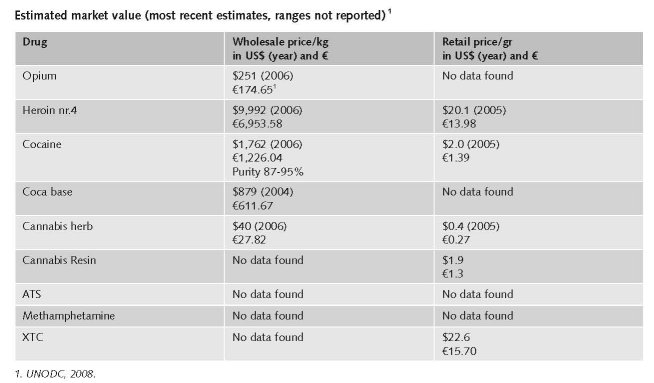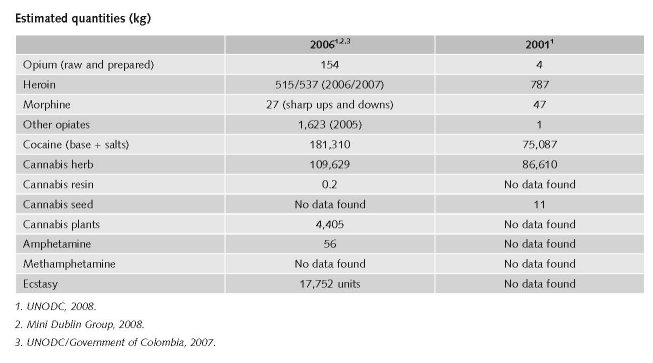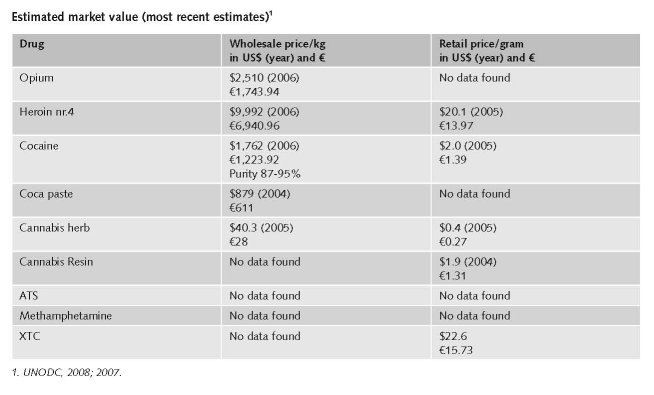Appendix to report 4: country reports COLOMBIA
| Reports - A Report on Global Illicit Drugs Markets 1998-2007 |
Drug Abuse
COLOMBIA
1 General information
Location:
Northern South America, bordering the Caribbean Sea, between Panama and Venezuela, and bordering the North Pacific Ocean, between Ecuador and Panama
Area:
1,138,910 sq km
Land boundaries/coastline:
6,309 km/ 3,208 km (Caribbean Sea 1,760 km, North Pacific Ocean 1,448 km)
Border countries:
Brazil 1,644 km, Ecuador 590 km, Panama 225 km, Peru 1,800 km, Venezuela 2,050 km
Population:
45,013,672 (July 2008 est.)
Age structure:
0-14 years: 29.4% (male 6,688,530/female 6,531,768)
15-64 years: 65.1% (male 14,292,647/female 15,017,204)
65 years and over: 5.5% (male 1,072,644/female 1,410,881) (2008 est.)
Administrative divisions:
32 departments and 1 capital district
GDP (purchasing power parity):
$327.7 billion (2007 est.)
GDP (official exchange rate):
$171.6 billion (2007 est.)
GDP- per capita (PPP):
$7,400 (2007 est.) (CIA World Factbook)
Drug research
Colombia has a small number of individual drug researchers and no drug research institutes. There is no national survey tradition (prevalence of drug use), thus there are no high-quality statistics on this subject. The “Observatório Nacional de Drogas” of the “Dirección Nacional de Estupefacientes” (the Monitoring Centre of the National Directorate of Psychotropic Substances) and the Ministry for Social Protection, are both responsible for drug demand reduction and drug policy. The Observatório is currently planning a national survey.
Main drug-related problems
Colombia is a producer of coca, opium poppy, and cannabis. It is the world’s largest producer of coca derivatives and supplies most of it to the US and other countries. Heroin exports are mostly for the US market.
2 Drug problems
2.1 Drug supply
2.1.1 Production

Additional information
“Colombian cocaine production estimates for 2004 and later are based on new research and cannot be directly compared with previous years.” (UNODC, 2008).
In spite of the gradual reduction of illicit cultivations in the past years, Colombia continues to be the biggest world cocaine producer with 62% of the global production (Mini Dublin Group, 2008).

Average wholesale price in 2007 for cocaine was $2,198/kg (€1,526.82) and for heroin, $10,780/kg (€7,487.36) (UNODC, 2008).
Prices (in US$) increased most from 2003 to 2007 for opium latex, heroin and cocaine Annual wholesale prices of cocaine increased from approximately $1,500 to $2,500/kg (€1,041.59 to €1,735.90).
Annual farm-gate prices of opium latex increased from $150 to nearly $300 (€104.19 to €208.40).
Annual wholesale prices of heroin increased from approximately $6,000 to $11,500/kg (€4,170.19 to €7,992.57) (UNODC, 2008).
Four characteristics of Colombian production are put forward that explain difficulties of developing estimates:
• Ill-defined growing seasons;
• Reduced field sizes due to eradication actions;
• Frequent cloudy skies hampering satellite detection;
• Growing cycles varying across regions making sometimes two crops per year possible
(Paoli, 2009).
2.1.1 Trafficking

The statistics on trafficking are considered unreliable because the total quantities that are trafficked annually are not known (Thoumi, 2005; expert’s comments).
Prices do not appear to be dependent on the amount of drugs seized on their way to consumers. Seizures may increase but the prices in the consumption countries remain fairly stable (expert’s comments).
Around 1990 a change in production volumes of cocaine took place. Organised crime succeeded in a transition from lower quantities and higher prices to larger quantities and lower prices. During recent years a roughly estimated average of 40% of the cocaine production is seized and 10% of the heroine production. One would expect that when the quantities of drugs seized are higher, then also the prices are becoming higher. Strangely enough this is not the case (expert’s comments).
In the eighties most Colombian cocaine went straight to the USA. Since the nineties most of it goes to Mexico. Mexican organised crime exports this to the USA because they could easier specialise it these trails. The Mexican organisations took it over. The result was that the import of Colombian cocaine is more hidden for the USA. The result is also that the Mexicans have now more trouble with the new American policy program compared with the Colombians (expert’s comments).

2.1.3 Retail/Consumption
No published national data found in English on retail/consumption
2.2 Drug Demand
2.2.1 Experimental/recreational drug users in the general population
Colombia has not established a legal framework and the necessary strong measures regarding drug consumption, treatment and rehabilitation (Mini Dublin Group, 2008).
During several years there has been a lack of interest in drug demand in Colombia. In 2007 however, Colombia was incorporated in a group of experts from several South American countries that, jointly with the OAS-CICAD and UNODC, promotes international best practices, research and surveys about drug use in schools, the general population, in the work place and in prisons. The results of the first general population survey have to be published yet. The last survey dates from 1998 (expert’s comments; Mini Dublin Group, 2008).
Two national surveys on drug use among the general population have been conducted in Colombia in the past, in 1992 and in 1996. In between a few surveys among young people have been published. Colombia is now planning a third general population survey on drug use. The proposals of the call for tender are evaluated now and the work may start in July 2008 (Ministério de la Protección Social, without year; expert’s comments).
No data (in English) were found on life-time and last-year prevalence in the general population in percentages.

2.2.2 Problematic drug users/chronic and frequent drug users
Colombia has not established a legal framework and the necessary strong measures regarding drug consumption, treatment and rehabilitation (Mini Dublin Group, 2008).
No data in English found on the number of problematic/chronic-frequent users (in the general population) and the number of injecting drug users (in the general population).
2.3 Drug related Harm
2.3.1 HIV infections and mortality (drug related deaths)
There is no programme for drug-related HIV a multi-year program to combat HIV infections in general (Ministerio de la Protección Social, 2008).
Heroin is not an important drug in Colombia. There are no statistics on injecting drug use, DRD and drug-related HIV (expert’s comments).
The number of HIV infected injecting drug users
In 2000 there were 6 cases of AIDS among injecting drug users and 5 cases of HIV infected people (Magis Rodríguez, 2002).
UNAIDS (2008) does not report recent numbers.
There are no data found on the number of newly HIV infected injecting drug users and on the number of drug related deaths by overdose.
2.3.2 Drug related crime or (societal) harm
During the past ten years Colombia has increasingly suffered from drug related crimes. This has started in the 90s (expert’s comments).
It remains difficult to discern drug-related crimes from crimes related to guerrilla warfare, because both are related (see also next area).
Production of cocaine is concentrated in several regions of the country. Illicit coca cultivation expanded in the 80s and 90s mainly in the remote areas of the Amazon basin. This may indicate that drug/related crime is also concentrated in these regions (UNODC/Government of Colombia, 2007).
3 Drug policy
3.1 General information
3.1.1 Policy expenditures
Expenditure statistics are not specifiable to illegal drugs. Money spent on drug-related actions and non-drug-related actions are impossible to separate in expenditure data. The same goes for guerrilla-directed actions (the guerrilla controls much of the drug production areas) and drug-directed actions. Both are related and the statistics are rarely separable (expert’s comments).
3.1.2 Other general indicators
No data were found on the numbers available on arrests and imprisonment for drug-law related offences.
3.2 Supply reduction: Production, trafficking and retail
General information
The Colombian government funds the SIMCI system for satellite determination of coca plantations in Colombia (Integrated System of Monitoring Illicit Cultivations). SIMCI is said to facilitate the analysis of changes in cultivation areas and steering eradication activities.” (Mini Dublin Group, 2008). However, the system may be unreliable because the technique is too crude.
There are two kinds of crop eradication measures, by airplanes and manual. The manual method is not very effective because most areas are controlled by the guerrilla, i.e. remote areas in the Amazon basi. (UNODC, 2007; expert’s comments).
Crop eradication may have been effective in the beginning of the 90s when there were very big plantations of poppy and coca leave. Nowadays there are very many small poppy plantations (expert’s comments). “The average field size decreased from 1.13 hectares in 2005 to 0.85 hectares in 2006 (25%). This could reflect farmer’s attempts to avoid detection and aerial spraying.” (UNODC/Government of Colombia, 2008).
Besides, poppy farmers are predominantly the owners of the land and coca leave farmers use public land. Thus, poppy farmers may be more effectively punished by confiscation of their land and/or incarceration instead of eradication of crops. This kind of punishments is less effective for coca farmers (expert’s comments). Furthermore, alternative development programs that are meant to offer farmers possibilities to produce legal products, have largely failed. (Vargas, 2005a). Furthermore, progress in the eradication of illicit cultivations in Colombia is partly counter-acted by displacing production to neighbouring countries, especially Peru, Bolivia and Equador (Mini Dublin Group, 2008).
Priorities of supply reduction covered by policy papers and/or law
The Plan Nacional de Lucha contra las Drogas 1998-2002 is formal policy but the anti-drug plans of the USA are predominant. From 1999 to 2005 the plan Colombia was dominant. After 2005 the USA plans have to be evaluated annually (expert’s comments).
In 2007 a national development plan was presented to the national Congress. It contains an integral plan for combating illegal drugs, without a specific funding strategy. Activities brought forward in this plan are funded by several sources including arrangements from international cooperation. Several proposed activities are decentralised to municipal level. The actions mentioned or foreseen (e.g. on drug prevention, treatment, and supply reduction) have not been activated yet. (OAS/CICAD, 2006) The present government defines five main areas for its counter-drug policy: illicit crops, interdiction and arms smuggling; money laundering and forfeiture of illegal assets; internal consumption; and shared responsibility (Plan Nacional de Desarrollo, 2007).
“U.S. anti-drug policy influences the Colombian armed conflict both directly and indirectly. The line between counter-insurgency and anti-drug policy has become blurred. The current policy has evolved from actions meant to curtail drug demand into national security considerations, reinforcing military involvement in Colombia’s armed conflict. This situation even affects fumigation decisions.” (Vargas, 2005).
The Colombian government has established a good system of legal tools for the extinction of domain of acquired assets by drug producers and drug traffickers. There were two new laws adopted and enforced in 2002, the laws 785 and 793, on domain extinction and money laundering (Mini Dublin Group, 2008).
In 1986 a law on illegal drugs was initiated, but little has happened in the following years. For instance drug users could not be put in prison anymore for the possession of small amounts of drugs, but this article gained insufficient political support because there was no political debate, it was not an important issue. Thus no actions have been undertaken to support this change in daily practice situations (expert’s comments).
3.3 Demand reduction: Experimental/recreational drug use + problematic use/chronic-frequent use
Prevention of drug use was initiated in former years, funded by the UNODC and with international cooperation (USA, UK, Germany, Swiss, Netherlands, Japan and Italy), but this funding stopped.
A broader oriented prevention program is currently running, the Competencias Cuidadanas, aiming at health promotion via life skills. Drugs are not easy to separate from the other subjects in this programme.

3.4 Harm reduction
3.4.1 HIV and mortality
There are no data found on harm reduction interventions.
Heroin and injecting drug use is not an important issue in Colombia. Harm reduction for drug dependent people has no high priority. There are no statistics on injecting drug use, Drug Related Deaths and drug-related HIV infections (expert’s comments). Colombia is not mentioned as a case for Latin America in the tables of the latest Global State of Harm Reduction (Cook & Kanaef, 2008).
3.4.2 Crime, societal harm, environmental damage
The two preceding administrations defined programmes to reduce harm caused by eradication as an emergency response to the problems caused by aerial spraying. The programmes were based on individual agreements or manual eradication pacts with these farmers. These programmes failed and farmers massively protested in 1996. The current presidency indicated that these programmes should target a structural regional development. USIAD provide more than 90% of the funds for these development programmes. However, the USIAD strategy leans on early eradication of illicit crops in exchange for funding local projects. This differs from the idea of the new President. The impetus is on eradication and the complex processes and agreements needed for regional development are not addressed. Besides, it is quite difficult to gain ground for the state in remote areas controlled by armed guerrilla groups (TNI Briefing series, 2003; International Crisis Group, 2008).
References
Consulted experts
C.A. Carvajal, Head of the Department of Demand reduction, UNODC.
F.E. Thoumi, Economist, Director of the Research and Monitoring Centre on Drugs and Crime, Universitad del Rosario, Bogotá.
R. Vargas, Sociologist, Director of Acción Andina Colombia, Bogotá.
Documents
CIA - The World Factbook – Colombia. Available: www.cia.gov/library/publications/the-world-factbook/ge-os/co.html, last accessed 10 December 2008.
Cook C, Kanaef N. Global state of harm reduction 2008. Mapping the response to drug-related HIV and hepatitis C epidemics. London, International Harm Reduction Association (IHRA), 2008.
Degenhardt L, Chiu WT, Sampson N, Kessler RC, Anthony JC, et al. Toward a global view of alcohol, tobacco, cannabis, and cocaine use : Findings from the WHO World Mental Health Surveys. Plos Medicine, 2008, July, 5(7), e141.
INCB (International Narcotics Board). Annual Report. Part III. Analysis of the world drug situation. 2007.
INCB (International Narcotics Control Board). Report of the International Narcotics Control Board for 2007. New York, United Nations, 2008.
International Crisis Group (ICG). Latin American drugs I: Losing the fight. ICG Latin America Report No. 25, March 2008.
Magis Rodríguez C, Marques LF, Touzé G. HIV and injecting drug use in Latin America. AIDS, 2002, 16(Suppl. 3): S34-S41.
Mini Dublin Group. Regional report for South America. Council of the European Union. Brussels, January 2008 (Cordrogue 10).
Ministerio de la Protección Social/Organisación Panamericana de la Salud. Situación de salud en Colombia. Indicatores básicos 2007. Available: www.ins.gov.co, last accessed 10 December 2008.
Ministerio de la Protección Social/Grupo de trabajo intersectorial en Vih y Sida. Plan nacional de repuesta ante el Vih y el Sida. Colombia 2008-2011. Bogotá, 2008.
Ministério de la Protección Social (MPS). Política Nacional para la reducción del consume de sustancias psicoactives y su impacto. Resumen ejecutivo. Bogotá, Ministério de la Protección Social (no year).
Available: www.minproteccionsocial.gov.co, last accessed 10 December 2008.
OAS/CICAD (Organisation of American States/ Inter American Commission on Drug Abuse Control). Colombia. Evaluación del progreso de control de drogas 2005-2006. MEM (Mecanismo de Evaluación Multilateral). 2006.
Plan nacional de Lucha contra las drogas: Colombia 1998-2002. Bogotá.
Available: www.cicad.oas.org/oid/mainpage/publications, last accessed 10 December 2008.
Plan Nacional de Desarrollo 2006-2010, Bogotá, 2007. Available: www.dne.org; www.cicad.oas.org, last accessed 10 December 2008.
Paoli L, Greenfield V, and Reuter P. The World Heroin Market: Can Supply be Cut? Oxford University Press. Forthcoming.
Thoumi FE. The numbers game: Let’s all guess the size of the illegal drug industry! Journal of Drug Issues, 2005 (Winter): 185-200.
TNI Briefing series. Alternative development and conflict in Colombia. Cross purposes. Amsterdam, Trans National Institute, 2003 (Debate papers No.7).
Vargas R. The anti-drug policy, aerial spraying of illicit crops and their social, environmental and political impacts in Colombia. Journal of Drug Issues 2005 (Winter):11-60.
Vargas R. Strategies for controlling the drug supply: Policy recommendations to deal with illicit crops and alternative development programs. Journal of Drug Issues, 2005a (Winter): 131-150.
UNDCP (United Nations International Drug Control Programme). Global Illicit Drug Trends 1999. New York, UNDCP, 1999.
UNODC/Government of Colombia. Coca cultivation survey. Bogotá, June 2007.
UNODC (Naciones Unidas Oficina contr la Droga y el Delito). Jóvenes y drogas en paises sudamericanos: un desafío para las políticas públicas. Primer studio comparative sobre uso de drogas en poblacion escolar secundaria de Argentina, Bolivia, Brasil, Colombia, Chile, Equador, Paraguay, Perú y Uruguay. Published by Tetis Graf E.I.R.L., Lima, 2006.
UNODC (United Nations Office on Drugs and Crime). World Drug Report 2007. Vienna, UNODC, 2007.
UNODC (United Nations Office on Drugs and Crime). World Drug Report 2008. Vienna, UNODC, 2008.
| < Prev | Next > |
|---|













